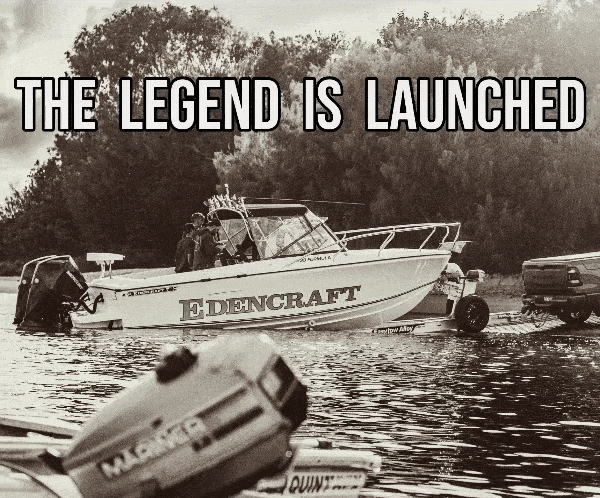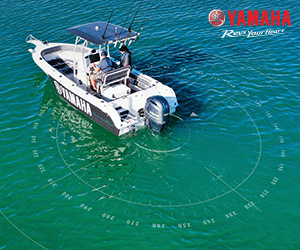Learning The Ropes – SEQ Offshore – Cody Hochen 2018
I purchased my first offshore worthy vessel just over a year ago: a 4.8m Galeforce. After paying my dues in the rivers of South-east Queensland and Moreton Bay in my tinnie for 7-8 years, it was time to focus on larger fish in the rich offshore waters of SEQ. It has been a steep learning curve, with a few donuts, but there have been some decent fish landed.
I am far from an expert, but have attained enough knowledge to provide options for fishermen who have similarly purchased their first offshore boat.
Locations
The advice I provide for choosing a location is to be prepared to travel. My offshore ventures in SEQ usually revolve around five locations, which are offshore from:
1. Noosa
2. Mooloolaba
3. Cape Moreton
4. South Passage Bar
5. Gold Coast Seaway
When planning an offshore trip, choosing a location can be difficult. During a few trips over the summer, I have donuted in one location, only to see my Facebook feed filled with fish from a location a mere 50 kilometres away. Maybe I wasn’t good enough to catch the fish on the given day, but sometimes the fish just are somewhere else. Since fishing offshore I have learnt that different areas hold different species at certain times of the year.
Location choice involves many aspects, such as size and direction of swell, wind, tide, time of year, and migration of a particular fish species.
A couple of examples are:
1. The reefs out from Noosa are a great place to fish and given the right day can produce a great diversity of pelagic species. Noosa bar, however is very shallow and can be a nightmare to cross, particularly during an easterly swell. Currently a shallow channel has opened up, making it a relatively easy prospect three hours either side of high tide on a good day. If there is a southerly swell, Laguna Bay gets great protection from Noosa headland, making the bar relatively safe to cross. If it is a bit rough further offshore, you can get a pelagic fix in Laguna Bay from late December – May, when schools of bait attract longtail tuna and spotted mackerel as well as the occasional Spanish mackerel, cobia and wahoo.
2. I was told by a few locals that during a south-east blow, warm and clean offshore water gets pushed into the inshore grounds off the Gold Coast. This in turn brings the bait and predators into these areas. This was evident in late December after a south-east blow pushed 26-degree water in close to the Gold Coast Seaway and Jumpinpin Bar. The warm water and bait attracted large numbers of juvenile black marlin on their annual migration south into 30- 40m of water out from the Seaway and Pin Bars.
Time of Year
You don’t have to be a rocket scientist to realise the warmer months are the peak times to chase pelagics in SEQ. However, during these warmer months, different species are more prevalent since they migrate up and down our coast in search of bait and warmer water.
1. Yellowtail kingfish are a species that seem to come close inshore in late winter and early spring. Large fish can be caught using surface lures fishing the bombies and reefs out from Cape Moreton, the northern end of North Stradbroke Island and on the reefs out from the mouth of the Tweed River.
2. Juvenile black marlin do their annual run south during summer and start appearing off the coast of SEQ around December. You can gauge the number of fish travelling down the coast and the time they will reach SEQ by how the game fishermen are fairing out from Fraser Island and Bundaberg. This year has turned out to be a cracker, with huge numbers being caught from offshore of Bundaberg and arriving offshore of SEQ in mid-December.
3. For the smaller boat brigade,the seasonal migration of spotted mackerel has been hard to gauge over the last 4-5 years. This year, however there seems to be large numbers of fish moving slowly down the coastline. Currently there are huge schools herding bait up on the inshore grounds of the Sunshine Coast and they have just started to trickle into Moreton Bay. I fished North Reef out from Noosa in early January and found some very active schools of spotties, with cobia lurking around the edges of the marauding schools. Small metal slugs, around 5–6cm did the damage with a few nice spotties around 80-90cm.
Weather
In my smaller offshore boat, I try to avoid swell over 1 metre,particularly when there has been an overnight breeze of more than 10 knots. Keep your eye on the swell and try to avoid northerly winds over 10 knots. Northerly winds seem to stir up dirty water close to shore, making the fishing super tough. Finding clean water, usually out wider is the key if fishing during northerly winds.
When planning a trip, I pay particular attention to MetEye on the Bureau of Meteorology’s website beforehand. I have found it to be the most accurate of all the weather prediction websites, providing 3-hour intervals for wind, waves, direction and size. It is particularly accurate for predicting wind direction changes so you can plan to head home before it gets too messy.
Bait, Water Temperature and Current
Bait, water temperature and current come hand in hand, and are the three most important aspects when it comes to targeting pelagics. If one of these elements is missing, it can lead to a tough day on the water.
When it comes to current, the best time to fish for pelagics is during periods of large tidal movement, particularly leading up to and after the full moon. The more the current, the more the bait is disturbed and disorientated, making them an easier meal for cruising pelagics. It is not always the case, but in my experience the prime bite time is the first push of current after a tide change. If this happens to be early in the morning when boat traffic is low, I recommend planning to have lines in the water at this stage rather than travelling and missing this key time.
On the full moon in late November, we ventured to Cape Moreton in search of some early season pelagics. We tried for a late season snapper at daybreak and after no luck, ventured to Hutchinson Shoals, north of Cape Moreton.
We started by trolling some hardbodies around the reef edges in search of bait and active fish. Instantly we found great shows of bait and plenty of active fish. While trolling I worked a floating stickbait out the front on my PE 6 outfit. After about 20 minutes, to my astonishment a 10 – 12kg Wahoo casually swam under the boat. I immediately cast my Masterbait Floating Stickbait in the direction it was heading.
Half way back to the boat it was smashed off the surface, with the wahoo fortunately heading away from our trolling outfits at an alarming rate. After a couple of blistering runs I soon had it boat side and in the esky. About 10 minutes later I hooked a larger wahoo that in a split second ran under and over the trolled lines, only to lose it at the boat. We noticed on the GPS that both fish had come from the exact location.
Looking at the sounder and the water around the area we could see why. We noticed the current was pushing into the reef, leaving a large current line. To make the situation even better, huge schools of bait were hanging around the area, no doubt becoming disorientated in the strong current and breakfast for the lurking wahoo. Once we realised this we deployed the electric motor, and pegged stickbaits beyond the current line. This immediately paid dividends, with another wahoo around the 10kg mark as well as half a dozen missed opportunities.
Water temperature is crucial when it comes to pelagics in SEQ. Pelagics travel up and down the coastline following these warmer currents. A classic example of how crucial a role water temperature plays when targeting pelagics, was highlighted over the Christmas break while trolling skirted pushers out from Jumpinpin bar. While trolling in close in 40 metres of water, I kept an eye on the water temperature as it fluctuated around 25 degrees.
After two hours of trolling, we could only find bait, but no fish, so we made the decision to head out to the 60 – 70 metre line. We set the spread and immediately found 26+ degree water. Within 15 minutes, a 12kg wahoo and a short while later, my first dolphin fish, around 6-7kg made it into the esky. It’s amazing the difference a degree or two can make.
Species
As mentioned, different species prefer different times throughout the pelagic season. However, if the conditions are right, you are in with a chance of catching anything. In spite of how bluewater species such as marlin and wahoo have been firing for about a month, inshore species such as Spanish and spotted mackerel have just arrived offshore from Brisbane.
In the last two years the water temperatures have remained warm into early winter, and Spanish mackerel have stayed around until then, particularly on the reefs out from Cape Moreton. Some likely locations to catch Spanish mackerel over the next few months are Sunshine Reef, North Reef, Cape Moreton and Boat Rock.
I find March and April to be a great time for targeting cobia; however currently there are plenty about. North Reef out from Noosa appears to be a cobia hotspot and seems to produce for me most times.
Techniques
There are so many techniques for targeting pelagics, with some being more successful than others on different species and during different times of the year. Below are two techniques that have been successful for me over the last month.
Trolling a spread of skirted pushers is a deadly way for targeting dolphin fish, wahoo and juvenile black marlin. I am very new to this method but am learning quickly. Trolling a spread of three or four 7–9 inch lures at different distances behind the boat at around 8 knots is a good start. It is imperative to keep your eyes glued to the sounder looking for bait balls, large fish and water temperature changes. If you find good numbers of bait or larger fish, concentrate your efforts around these areas.
Stickbaiting and popping has become one of the deadliest and exciting techniques for catching many pelagics. Kingfish, wahoo, Spanish mackerel, dolphin fish, yellowfin tuna, longtail tuna and giant trevally, all respond very well to this technique and can provide endless entertainment. There’s nothing more exciting than seeing a Spanish mackerel launch out of the depths to attack your lure.
There is an endless and overwhelming supply of stickbaits and poppers on the market. I recommend to buy a variety of floating and sinking stickbaits. Maria, Shimano, Nomad and Duo make a good starting product that won’t break the budget. Other than Halco Roosters there aren’t many cheap alternatives. Black Magic make a reasonably priced popper that I recommend. To chase mackerel and wahoo I have been using a PE6 Shimano Grappler with a 10,000 Shimano Biomaster.
Just in
It’s mid-January and the spotties have arrived in the bay. A mate had a great session along the southern end of Bribie Island with fish up to 85cm. On the same day I had a fun session on smaller fish around the 70cm mark, 2kms out from the Sand Hills on Moreton Island. There are generally plenty of boats chasing them, so get out early to avoid the crowds. They were chasing both frogmouth pilchards and a much smaller baitfish around 1 ½ inches long, making them very hard to tempt when focused on smaller bait. Switching to smaller 15 – 20-gram metal lures and smaller paddle tail plastics on ½ ounce jigheads managed to tempt a few of the fish. Over the next few weeks, these fish should move into the central and southern bay and will be found in the paddock between Harry Atkinson Artificial and Green Island and further south on the northern/eastern or western side of Peel Island.
If the weather behaves, there will be some exciting pelagic fishing over the next few months. It is early in the season and we have experienced excellent weather and some red hot action so far. With larger schools of tuna and mackerel still making their way down the coast, make sure your reels are serviced and your drag is smooth.





